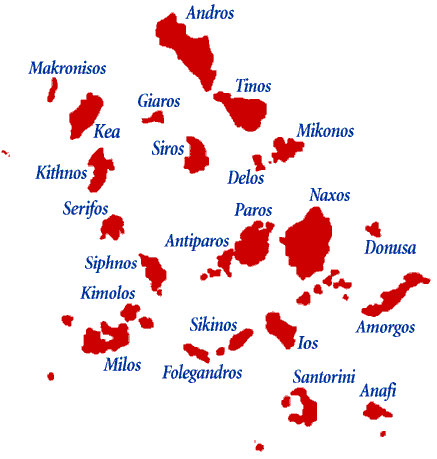Amorgos | Anafi | Andros | Antiparos | Delos | Donousa | Folegandros | Giaros | Iraklia | Ios | Kea | Kimolos | Koufonissi | Kythnos | Makronisos | Mykonos | Milos | Naxos | Paros | Santorini | Serifos | Sikinos | Skhinoussa | Siphnos | Syros | Tinos
Invariably picturesque - sugar cube architecture, windmills, golden
beaches, blue seas - the Cyclades are everybody's idea of what
Greek islands ought to be. They are also a worthy destination
for those willing to explore deeper into Aegean history and culture.
Andros, the northernmost island, is the greenest, with many springs
and cypress groves. Grand homes characterize its capital, due
to a significant shipping tradition. Naxos, the largest, possesses
the only year-round rivers in the Cyclades; its fertile valleys
produce abundant fruit, olive oil and wine. Santorini, the southernmost,
is the site of the largest volcanic eruption in recorded history.
The capital of the Cyclades is Ermoupolis, on the island of Siros,
an important shipping and commercial center in the Aegean.
Legend has it that the Cyclades were created when Poseidon struck
the mountains of Greece with his trident, scattering them into
the Aegean. The name refers to the circle (kyklos) the islands make around Delos, reputedly the birthplace of Artemis
and Apollo. Home to the Cycladic culture (3,000 1,000 BC), the
islands have witnessed a series of civilizations and rulers come
and go. Commerce can be dated to trade in obsidian from Milos,
circa 11,000 BC. The Cyclades joined the Greek nation after the
Revolution of 1821.


Copyright: Hellenic Electronic Center (Poseidon).
Site design and graphics: Chris Theoharis.